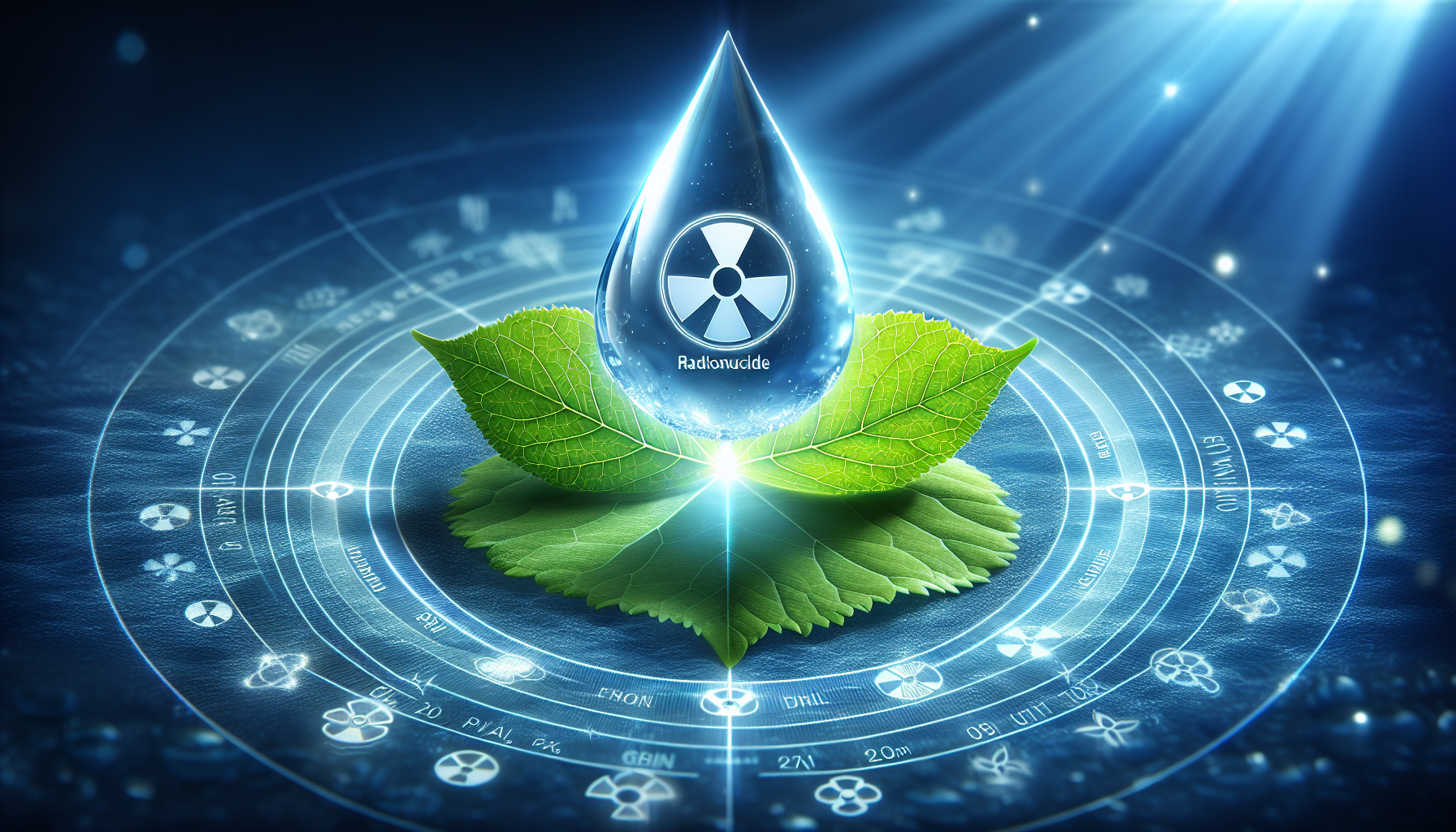If you’re concerned about the potential contamination of your well water by radionuclides, you’re not alone. Many people are becoming increasingly aware of the presence of these harmful substances and are seeking effective ways to eliminate them. In this article, we will explore some practical steps you can take to ensure your well water remains safe and free from radionuclide contamination. From testing your water to implementing proper filtration systems, we’ve got you covered. So, let’s dive into the world of well water purification and discover how you can safeguard your family’s health.

Understanding Well Water Contamination by Radionuclides
Well water contamination by radionuclides is a significant concern that can have serious health implications. Radionuclides are unstable atoms that emit radiation as they undergo radioactive decay. These radioactive substances can enter well water through various means, posing a risk to those who consume it. It is crucial to understand the sources of radionuclide contamination and the associated health risks to ensure the safety of well water.
What are radionuclides?
Radionuclides are atoms with unstable nuclei that emit radiation in the form of alpha particles, beta particles, or gamma rays. They are prevalent in nature and can also be produced artificially. Some common examples of radionuclides include uranium, radium, radon, and strontium. These radioactive substances can contaminate well water and have detrimental effects on human health if consumed.
How do radionuclides contaminate well water?
Radionuclides can contaminate well water through various pathways. One significant source is naturally occurring deposits of uranium and radium in underground rock formations. As water flows through these rocks, it can dissolve these radioactive substances and carry them into wells. Another source of radionuclide contamination is human activities, such as mining and nuclear power plants, which can release radioactive materials into the environment. Additionally, radon gas, which is a decay product of radium, can infiltrate well water from the surrounding soil.
Why is well water contamination by radionuclides a concern?
Well water contamination by radionuclides is a concern due to the potential health risks associated with exposure to radiation. Prolonged consumption of radionuclide-contaminated water can lead to an increased risk of developing various diseases, including cancer. Children and infants are especially vulnerable to the harmful effects of radiation. It is essential to address this issue to ensure the well-being of individuals who rely on well water for their drinking and daily needs.
Health risks associated with radionuclide contamination
Exposure to radionuclides in contaminated well water can pose several health risks. Chronic exposure to radionuclides, such as uranium and radium, has been linked to an increased risk of cancer, especially in organs like the kidneys and bladder. Radon, a radioactive gas, is associated with a higher likelihood of lung cancer when inhaled. Additionally, radionuclides can have adverse effects on reproductive health and can impair the functioning of various body systems. It is crucial to address these risks and take appropriate measures to mitigate radionuclide contamination in well water.
Identifying Radionuclide Contamination in Well Water
Identifying radionuclide contamination in well water requires thorough testing and analysis. Regular monitoring of well water quality is essential to ensure the safety of drinking water. Several testing methods can detect the presence of radionuclides, including gamma spectroscopy and liquid scintillation counting. These tests can determine the concentration of radionuclides present in well water and provide insights into potential contamination sources.
Testing well water for radionuclides
To test well water for radionuclides, it is recommended to consult with a certified laboratory specializing in water analysis. They can provide appropriate sampling containers and detailed instructions on how to collect a representative sample. The collected sample can then be sent to the laboratory for testing. The analysis will determine the levels of different radionuclides present in the water and compare them to established threshold levels for safe drinking water.
Common radionuclides found in well water
Common radionuclides found in well water include uranium, radium, radon, and strontium. Uranium and radium are often naturally occurring in rock formations and can dissolve and contaminate groundwater. Radon gas, a decay product of uranium and radium, can seep into well water from the surrounding soil. Strontium-90, a byproduct of nuclear power generation, may also be present in areas near nuclear facilities. It is important to be aware of these contaminants when testing well water for radionuclides.
Threshold levels for safe drinking water
Threshold levels for safe drinking water vary depending on the specific radionuclide and the country’s regulatory standards. In the United States, the Environmental Protection Agency (EPA) has set maximum contaminant levels for radionuclides in public water systems. For example, the maximum allowable concentration for uranium is 30 micrograms per liter (µg/L), while for radium-226 and radium-228, it is 5 picocuries per liter (pCi/L). It is crucial to compare the test results with these threshold levels to ensure compliance with water safety standards.
Symptoms and signs of radionuclide contamination
Radionuclide contamination in well water may not always cause immediate noticeable symptoms. However, prolonged exposure to contaminated water can have long-term health effects. Some signs that may indicate radionuclide contamination include a metallic taste in the water, staining or discoloration of fixtures, and a noticeable odor. It is important to be vigilant and proactive in testing well water quality to prevent potential health risks associated with radionuclide contamination.
Causes of Radionuclide Contamination in Well Water
Radionuclide contamination in well water can occur through natural processes or as a result of human activities. Understanding the causes of radionuclide contamination is crucial to develop effective prevention and mitigation strategies.
Naturally occurring radionuclides
Naturally occurring radionuclides, such as uranium, radium, and radon, can be found in rocks and soil. These radioactive substances have the potential to dissolve into groundwater when water flows through underground formations. Depending on the geological composition of the area, well water may be susceptible to higher concentrations of these naturally occurring radionuclides. It is important to consider the local geology and understand the potential for natural radionuclide contamination in well water sources.

Human activities contributing to radionuclide contamination
Human activities can also contribute to radionuclide contamination in well water. Industries such as mining and nuclear power plants may release radioactive materials into the environment. Improper waste disposal practices or accidents can lead to the contamination of groundwater sources. It is crucial to identify potential sources of contamination and take appropriate measures to prevent the release of radionuclides into the environment.
Localized and widespread contamination sources
Radionuclide contamination in well water can originate from localized or widespread sources. Localized contamination sources may include nearby industries or facilities that release radioactive materials into the environment. In such cases, the contamination may be limited to specific areas or wells in proximity to the source. Widespread contamination sources, such as naturally occurring deposits, can affect a broader region and may require comprehensive monitoring and mitigation efforts. Understanding the nature of contamination sources is essential for implementing effective preventive measures.
Preventing Radionuclide Contamination in Well Water
Prevention is key to mitigating radionuclide contamination in well water. By implementing preventive measures, the risk of contamination can be minimized, safeguarding the quality and safety of well water for consumption and other uses.
Understanding the hydrogeology of the well
Understanding the hydrogeology of the well is crucial for preventing radionuclide contamination. Factors such as the type of rock formations, groundwater flow paths, and well construction can influence the potential for contamination. Consulting with hydrogeologists or groundwater experts can provide valuable insights into potential contamination risks and inform well location and design decisions.
Providing proper well construction and maintenance
Proper well construction and maintenance practices play a critical role in preventing radionuclide contamination. Ensuring that wells are properly sealed and constructed to prevent the infiltration of surface contaminants is essential. Regular maintenance, including monitoring the integrity of well casings and conducting checks for potential sources of contamination, can help identify and address any issues promptly.
Avoiding potential contamination sources
Preventing radionuclide contamination in well water also involves avoiding potential sources of contamination. When selecting a well location, it is important to consider the proximity to industrial facilities, mining sites, or areas with known radionuclide deposits. By choosing a location away from potential contamination sources, the risk of radionuclide contamination can be significantly reduced.

Monitoring and regular testing of well water quality
Regular monitoring and testing of well water quality are essential preventive measures. Periodic testing for radionuclides can help identify any changes in water quality and detect potential contamination. Establishing a regular testing schedule and adhering to it can provide valuable data and ensure the timely detection of radionuclide contamination. This allows for prompt action to be taken to safeguard the well water and the health of those who rely on it.
Treating Radionuclide Contamination in Well Water
If radionuclide contamination is detected in well water, various treatment methods can be employed to eliminate or reduce the levels of these radioactive substances. Depending on the specific radionuclide present and its concentration, different treatment options may be suitable.
Activated carbon filtration
Activated carbon filtration is an effective method for removing radionuclides from well water. The porous structure of activated carbon can adsorb radionuclides, trapping them and preventing their passage through the filtration system. This process can significantly reduce the levels of radionuclides in well water, making it safe for consumption.
Reverse osmosis
Reverse osmosis is another treatment method commonly used to remove radionuclides from well water. In this process, water is passed through a semi-permeable membrane that blocks the passage of contaminants, including radionuclides. Reverse osmosis can effectively reduce the concentration of radionuclides, providing purified water for consumption.
Ion exchange
Ion exchange involves the use of a resin that selectively absorbs and exchanges ions present in well water. This process can effectively remove radionuclides by replacing them with less harmful ions. Ion exchange is particularly effective in treating water contaminated with radium and uranium.
Distillation
Distillation is a heating and cooling process that removes contaminants, including radionuclides, from well water. The water is heated to produce steam, and then condensed back into liquid form, leaving behind the contaminants. Distillation can be an efficient method for removing radionuclides, ensuring the water’s safety.

Coagulation and filtration
Coagulation and filtration involve adding coagulants to well water, causing contaminants to cluster together and form larger particles. These particles are then removed through filtration processes. This method can be effective in reducing radionuclides and other contaminants, improving the overall water quality.
Electrodialysis
Electrodialysis is a process that uses an electric current to remove charged particles, including radionuclides, from water. The water is passed through a series of ion-exchange membranes, creating a separation of ions based on their charge. Electrodialysis can effectively reduce the concentration of radionuclides, providing safe water for consumption.
Choosing the right treatment method for specific radionuclides
Choosing the appropriate treatment method is crucial for effectively eliminating radionuclide contamination in well water. Different treatment methods target specific radionuclides, so it is essential to identify the specific contaminants present in well water through testing. Seeking professional advice from water treatment specialists can help determine the most suitable treatment method for a particular situation.
Choosing a Water Treatment System for Radionuclides
When selecting a water treatment system for radionuclides, several factors should be considered to ensure an optimal solution for eliminating contamination.
Considering water quality analyses
Before choosing a treatment system, it is important to conduct a comprehensive analysis of the water quality, specifically focusing on radionuclides. This analysis will identify the specific contaminants present, their concentration, and any other water quality parameters that may affect the treatment process. This information is crucial for selecting the most appropriate treatment system.
Evaluating treatment system effectiveness
It is essential to evaluate the effectiveness of different treatment systems in removing radionuclides. This can be done by reviewing independent testing data, consulting with water treatment experts, and considering the track record of various treatment systems. Understanding the proven effectiveness of a treatment system is crucial in ensuring the desired outcomes of radionuclide removal.

Comparing treatment costs and maintenance requirements
Treatment costs and maintenance requirements can vary significantly among different treatment systems. It is important to consider the initial investment, as well as the ongoing operation and maintenance costs associated with each treatment option. Additionally, the availability and cost of replacement parts and consumables should also be taken into account. Comparing these factors will help determine the most cost-effective and sustainable treatment solution.
Seeking professional advice
Selecting the right water treatment system for radionuclides can be complex. Consulting with water treatment professionals or engaging the services of experienced water treatment companies can provide valuable guidance. These experts can assess the specific radionuclide contamination situation and recommend suitable treatment systems that meet individual needs and requirements.
Disposing Radionuclide-contaminated Water
Proper disposal of radionuclide-contaminated water is crucial to prevent further contamination and protect the environment. Disposal methods must comply with local regulations and guidelines to ensure safe and responsible handling of the contaminated water.
Proper disposal methods
Disposal methods for radionuclide-contaminated water may vary depending on the specific radionuclides present and their concentration. Dilution and dispersion may be an acceptable method for some cases if the contamination levels are within allowable limits. In other instances, contacting wastewater treatment facilities that are equipped to handle radioactive waste may be the appropriate course of action.
Local regulations and guidelines
When disposing of radionuclide-contaminated water, it is essential to adhere to local regulations and guidelines. Different jurisdictions may have specific requirements for the disposal of radioactive waste. These regulations aim to protect public health and the environment from the potential dangers associated with radionuclide contamination. Familiarizing oneself with these regulations and following them carefully is crucial to ensure compliance and responsible disposal.
Collaborating with wastewater treatment facilities
In some cases, collaborating with wastewater treatment facilities may be necessary for the proper disposal of radionuclide-contaminated water. These facilities have the expertise and infrastructure to handle radioactive waste and can ensure that the contaminated water is treated and disposed of in a safe and controlled manner. Collaborating with such facilities can provide peace of mind and ensure that the disposal process is carried out effectively.
Long-term Solutions for Well Water Contamination
Addressing radionuclide contamination in well water requires long-term solutions to protect public health and the environment.
Advocating for stricter regulations and monitoring
Advocacy for stricter regulations and monitoring of radionuclide contamination is essential. By working towards more comprehensive and stringent regulatory standards, the prevention and control of radionuclide contamination can be improved. This could involve advocating for regular testing and monitoring of well water sources and implementing stricter guidelines for industries and facilities that may contribute to radionuclide contamination.
Research and innovation for improved treatment methods
Continued research and innovation are crucial for developing and improving treatment methods for radionuclide contamination. Investing in research efforts can lead to the discovery of more effective and efficient treatment technologies. This includes exploring advanced filtration systems, chemical processes, and emerging technologies that can provide superior removal of radionuclides from well water.
Developing sustainable water management practices
Developing sustainable water management practices is vital in preventing radionuclide contamination in well water. This involves implementing water conservation measures to reduce reliance on groundwater sources, promoting responsible land use practices to protect water sources from contamination, and supporting sustainable agricultural practices. By adopting these practices, the overall quality and availability of well water can be safeguarded for future generations.
Educating Communities about Radionuclide Contamination
Educating communities about radionuclide contamination is crucial for raising awareness and promoting proactive measures to ensure well water safety.
Raising awareness on health risks
Raising awareness about the health risks associated with radionuclide contamination is an important first step in educating communities. Informing individuals about the potential adverse effects of consuming radionuclide-contaminated water can help foster a sense of urgency and motivate action. This can be done through community outreach programs, educational campaigns, and dissemination of informational materials.
Providing guidance on well water testing and treatment
Providing guidance on well water testing and treatment is essential to empower communities to take proactive measures. Educating individuals on how to properly collect water samples for testing and understand the test results can enable them to make informed decisions about well water safety. Additionally, offering guidance on treatment options and connecting communities with resources, such as certified laboratories and water treatment specialists, can help address radionuclide contamination effectively.
Promoting community involvement in water protection
Promoting community involvement in water protection initiatives is crucial for sustaining well water safety. Engaging community members in monitoring and reporting potential contamination sources can help identify issues early on. Encouraging responsible water use practices and promoting the importance of regular well water testing can create a sense of collective responsibility and active participation in safeguarding the community’s water resources.
Conclusion
Addressing radionuclide contamination in well water requires a comprehensive approach that includes understanding the sources and health risks, identifying contamination through testing, implementing preventive measures, and employing effective treatment methods. Choosing the right water treatment system, disposing of contaminated water responsibly, and advocating for stricter regulations and monitoring are crucial for long-term solutions. By educating communities and promoting community involvement, the importance of well water safety can be emphasized, and proactive measures can be encouraged. With these actions, the risk of radionuclide contamination in well water can be significantly reduced, ensuring the well-being and health of individuals who rely on this vital resource. So, take the necessary steps to eliminate well water contamination by radionuclides, and enjoy the peace of mind that comes with safe and clean well water.

